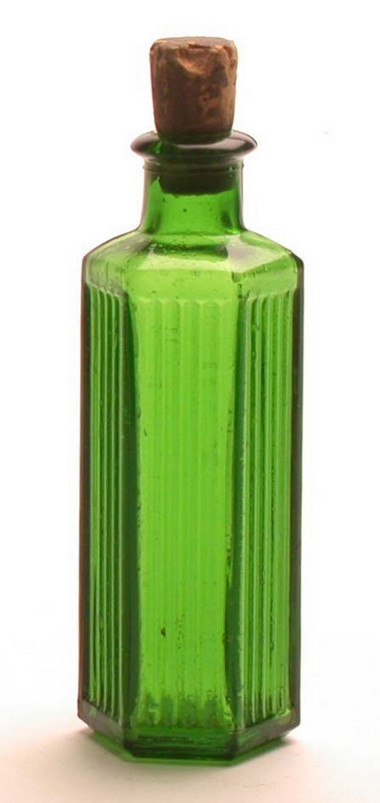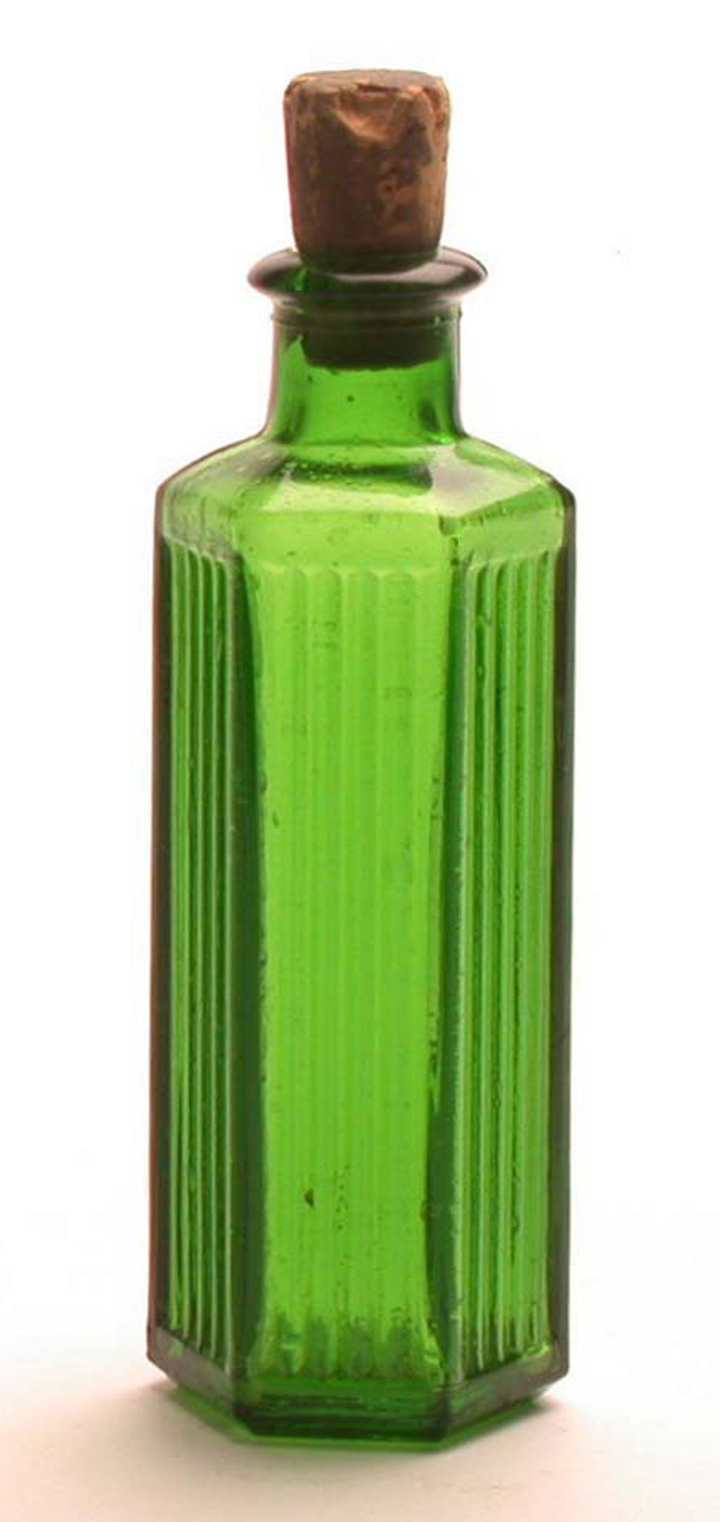Poison Bottle, Victorian, Original
Poison! Beware! This poison bottle is made out of green glass, and has six sides, three of which are flat and three of which are fluted. This distinctive shape would alert you to the fact it was the poison bottle if you were searching for a bottle, or feeling your way in the medicine cupboard in the dark. Green glass was popular for poisons in the nineteenth century.
The bottle is slightly indented and marked with a number 2 on the base. The neck of the bottle is quite short and has a cork stopper. Many similar medicine bottles had glass stoppers as the medicine, or poison, would stick to the cork and make it difficult to use. Bottles are extremely difficult to date, as glassmakers long continued to make them by hand after the introduction of machine moulding.
One of the most widely available poisons during the Victorian period was arsenic. Arsenic could be legitimately bought over the counter by women wishing to improve their complexion, or by anyone wishing a long-term improvement to their breathing when climbing. Immediate side effects were vomiting and diarrhoea. The victim would eventually die of renal failure, or a heart attack. Poisoning was seen as a sophisticated crime - this was the era of the high profile poisoner.
The bottle is slightly indented and marked with a number 2 on the base. The neck of the bottle is quite short and has a cork stopper. Many similar medicine bottles had glass stoppers as the medicine, or poison, would stick to the cork and make it difficult to use. Bottles are extremely difficult to date, as glassmakers long continued to make them by hand after the introduction of machine moulding.
One of the most widely available poisons during the Victorian period was arsenic. Arsenic could be legitimately bought over the counter by women wishing to improve their complexion, or by anyone wishing a long-term improvement to their breathing when climbing. Immediate side effects were vomiting and diarrhoea. The victim would eventually die of renal failure, or a heart attack. Poisoning was seen as a sophisticated crime - this was the era of the high profile poisoner.

Height:13cm
In 1815 an Act of Parliament established the right of chemists and druggists to buy, compound, dispense and sell drugs and medicines. In 1852 a register of chemists and druggists was set up by The Pharmaceutical Society of Great Britain to introduce examination and regulation in the dispensing of drugs, medicines and poisons to the general public.
The Victorian chemist shop, or pharmacy, had a distinctive window display of large carboys (glass containers) full of coloured liquids to suggest medicines. During the nineteenth century there was a rise in the production of patent medicines that people could buy if they were confident enough to diagnose themselves. Some of these medicines and ointments, we now know, were completely useless but they would be displayed in the window to attract customers.
Once inside the shop the fittings had their own style. The drug run was a wall of drawers usually behind the counter. Drawers had gold or painted labels telling the chemist what was inside. Contents could be herbs, roots, and a wide variety of powdered chemicals. Above the drawers was a set of shelves holding special chemists glass jars called specie jars. They held syrups and oils. Specie jars had elaborate scrolled labels, often printed in gold. Aether rounds were special containers used for explosive liquids. The glass stoppers in these containers were covered by heavy glass domes that would catch the stoppers if the liquids blew them out of the neck of the container.
The chemist had a large stock of medicine bottles and corks in a variety of sizes to dispense medicine to customers. At the beginning of the nineteenth century liquid medicines were dispensed in bottles giving one dose at a time. As the century progressed multi-dose portions were dispensed in larger bottles. Medicine bottles were usually octagonal, and recyclable, often having the name of the chemist moulded in the glass. Cork borers and cork presses enabled chemists to recycle corks.
The chemist shop was a good place to come to buy medical equipment, such as vaporisers, medicine spoons, bronchitis kettles, sputum mugs, bedpans, enema syringes, feeding cups and eyebaths. Chemists began to extend their product range into toiletries, to include perfumes, hair lotions, soaps and cosmetics. Infant and invalid foods were also popular selling lines.
After Joseph Lister introduced antiseptic in 1867, the need to sterilise medical instruments both at home and in hospital was acknowledged. The ability to clean an item properly became part of the design solution, and many products were discarded as being too difficult to clean, and therefore detrimental to personal and public health. Metal, a material that was easily sterilised, began to take over from wood, ivory and horn.
The Victorian chemist shop, or pharmacy, had a distinctive window display of large carboys (glass containers) full of coloured liquids to suggest medicines. During the nineteenth century there was a rise in the production of patent medicines that people could buy if they were confident enough to diagnose themselves. Some of these medicines and ointments, we now know, were completely useless but they would be displayed in the window to attract customers.
Once inside the shop the fittings had their own style. The drug run was a wall of drawers usually behind the counter. Drawers had gold or painted labels telling the chemist what was inside. Contents could be herbs, roots, and a wide variety of powdered chemicals. Above the drawers was a set of shelves holding special chemists glass jars called specie jars. They held syrups and oils. Specie jars had elaborate scrolled labels, often printed in gold. Aether rounds were special containers used for explosive liquids. The glass stoppers in these containers were covered by heavy glass domes that would catch the stoppers if the liquids blew them out of the neck of the container.
The chemist had a large stock of medicine bottles and corks in a variety of sizes to dispense medicine to customers. At the beginning of the nineteenth century liquid medicines were dispensed in bottles giving one dose at a time. As the century progressed multi-dose portions were dispensed in larger bottles. Medicine bottles were usually octagonal, and recyclable, often having the name of the chemist moulded in the glass. Cork borers and cork presses enabled chemists to recycle corks.
The chemist shop was a good place to come to buy medical equipment, such as vaporisers, medicine spoons, bronchitis kettles, sputum mugs, bedpans, enema syringes, feeding cups and eyebaths. Chemists began to extend their product range into toiletries, to include perfumes, hair lotions, soaps and cosmetics. Infant and invalid foods were also popular selling lines.
After Joseph Lister introduced antiseptic in 1867, the need to sterilise medical instruments both at home and in hospital was acknowledged. The ability to clean an item properly became part of the design solution, and many products were discarded as being too difficult to clean, and therefore detrimental to personal and public health. Metal, a material that was easily sterilised, began to take over from wood, ivory and horn.

Height:13cm

Poison! Beware! This poison bottle is made out of green glass, and has six sides, three of which are flat and three of which are fluted. This distinctive shape would alert you to the fact it was the poison bottle if you were searching for a bottle, or feeling your way in the medicine cupboard in the dark. Green glass was popular for poisons in the nineteenth century.
The bottle is slightly indented and marked with a number 2 on the base. The neck of the bottle is quite short and has a cork stopper. Many similar medicine bottles had glass stoppers as the medicine, or poison, would stick to the cork and make it difficult to use. Bottles are extremely difficult to date, as glassmakers long continued to make them by hand after the introduction of machine moulding.
One of the most widely available poisons during the Victorian period was arsenic. Arsenic could be legitimately bought over the counter by women wishing to improve their complexion, or by anyone wishing a long-term improvement to their breathing when climbing. Immediate side effects were vomiting and diarrhoea. The victim would eventually die of renal failure, or a heart attack. Poisoning was seen as a sophisticated crime - this was the era of the high profile poisoner.
The bottle is slightly indented and marked with a number 2 on the base. The neck of the bottle is quite short and has a cork stopper. Many similar medicine bottles had glass stoppers as the medicine, or poison, would stick to the cork and make it difficult to use. Bottles are extremely difficult to date, as glassmakers long continued to make them by hand after the introduction of machine moulding.
One of the most widely available poisons during the Victorian period was arsenic. Arsenic could be legitimately bought over the counter by women wishing to improve their complexion, or by anyone wishing a long-term improvement to their breathing when climbing. Immediate side effects were vomiting and diarrhoea. The victim would eventually die of renal failure, or a heart attack. Poisoning was seen as a sophisticated crime - this was the era of the high profile poisoner.




















